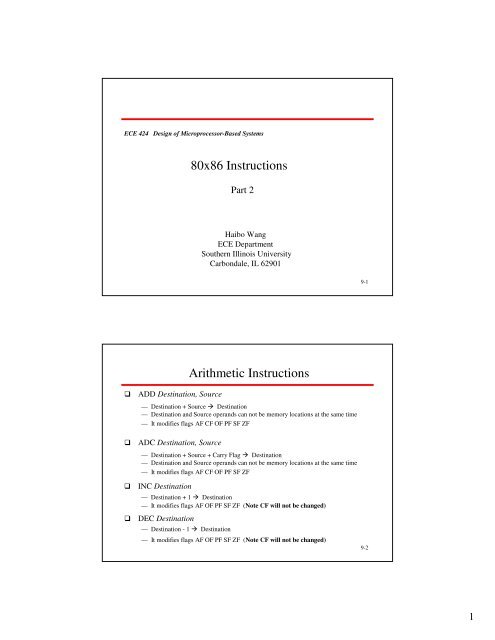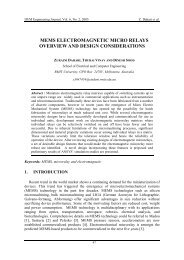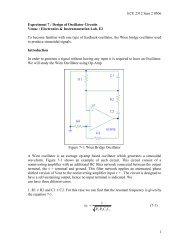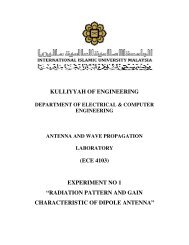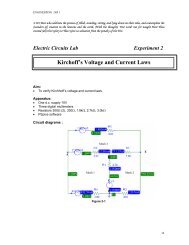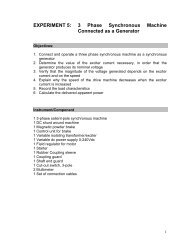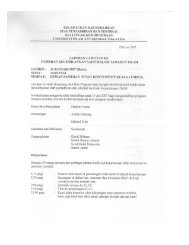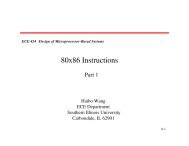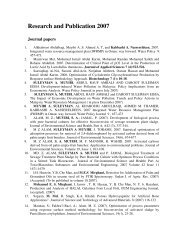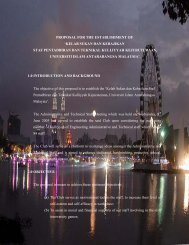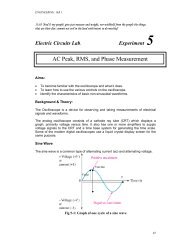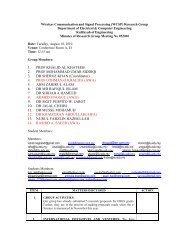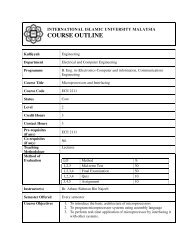8088/8086 Instruction 2
8088/8086 Instruction 2
8088/8086 Instruction 2
Create successful ePaper yourself
Turn your PDF publications into a flip-book with our unique Google optimized e-Paper software.
Arithmetic <strong>Instruction</strong>sSUB Destination, Source— Destination - Source Destination— Destination and Source operands can not be memory locations at the same time— It modifies flags AF CF OF PF SF ZFSBB Destination, Source— Destination - Source - Carry Flag Destination— Destination and Source operands can not be memory locations at the same time— It modifies flags AF CF OF PF SF ZFCMP Destination, Source— Destination – Source (the result is not stored anywhere)— Destination and Source operands can not be memory locations at the same time— It modifies flags AF CF OF PF SF ZF (if ZF is set, destination = source)9-3 MUL SourceArithmetic <strong>Instruction</strong>s— Perform unsigned multiply operation— If source operand is a byte, AX = AL * Source— If source operand is a word, (DX AX) = AX * Source— Source operands can not be an immediate data— It modifies CF and OF (AF,PF,SF,ZF undefined) IMUL Source— Perform signed binary multiply operation— If source operand is a byte, AX = AL * Source— If source operand is a word, (DX AX) = AX * Source— Source operands can not be an immediate data— It modifies CF and OF (AF,PF,SF,ZF undefined) Examples:MOV AL, 20HMOV CL, 80HMUL CLMOV AL, 20HMOV CL, 80HIMUL CL9-42
DIV Source— Perform unsigned division operation— If source operand is a byte, AL = AX / Source; AH = Remainder of AX / Source— If source operand is a word, AX=(DX AX)/Source; DX=Remainder of (DX AX)/Source— Source operands can not be an immediate data IDIV SourceArithmetic <strong>Instruction</strong>s— Perform signed division operation— If source operand is a byte, AL = AX / Source; AH = Remainder of AX / Source— If source operand is a word, AX=(DX AX)/Source; DX=Remainder of (DX AX)/Source— Source operands can not be an immediate data Examples:MOV AX, 5MOV BL, 2DIV BLMOV AL, -5MOV BL, 2IDIV BL9-5 NEG DestinationArithmetic <strong>Instruction</strong>s— 0 – Destination Destination (the result is represented in 2’s complement)— Destination can be a register or a memory location— It modifies flags AF CF OF PF SF ZF CBW— Extends a signed 8-bit number in AL to a signed 16-bit data and stores it into AX— It does not modify flags CWD— Extends a signed 16-bit number in AX to a signed 32-bit data and stores it into DXand AX. DX contains the most significant word— It does not modify flags Other arithmetic instructions:DAA, DAS, AAA, AAS, AAM, AAD9-63
NOT DestinationLogical <strong>Instruction</strong>s— Inverts each bit of the destination operand— Destination can be a register or a memory location— It does not modify flags AND Destination, Source— Performs logic AND operation for each bit of the destination and source; stores theresult into destination— Destination and source can not be both memory locations at the same time— It modifies flags: CF OF PF SF ZF OR Destination, Source— Performs logic OR operation for each bit of the destination and source; stores theresult into destination— Destination and source can not be both memory locations at the same time— It modifies flags: CF OF PF SF ZF9-7Bit Manipulation <strong>Instruction</strong>s SHL(SAL) Destination, Count— Left shift destination bits; the number of bits shifted is given by operand Count— During the shift operation, the MSB of the destination is shifted into CF andzero is shifted into the LSB of the destination— Operand Count can be either an immediate data or register CL— Destination can be a register or a memory location— It modifies flags: CF OF PF SF ZFCF Destination0MSB SHR Destination, Count— Right shift destination bits; the number of bits shifted is given by operand Count— During the shift operation, the LSB of the destination is shifted into CF andzero is shifted into the MSB of the destination— Operand Count can be either an immediate data or register CL— Destination can be a register or a memory location— It modifies flags: CF OF PF SF ZFLSB0 DestinationMSBLSBCF9-84
SAR Destination, CountBit Manipulation <strong>Instruction</strong>s— Right shift destination bits; the number of bits shifted is given by operand Count— The LSB of the destination is shifted into CF and the MSB of the destination remiansthe same— Operand Count can be either an immediate data or register CL— Destination can be a register or a memory location— It modifies flags: CF PF SF ZFDestinationCFMSBLSB9-9 ROL Destination, CountBit Manipulation <strong>Instruction</strong>s— Left shift destination bits; the number of bits shifted is given by operand Count— The MSB of the destination is shifted into CF, it also goes to the LSB of the destination— Operand Count can be either an immediate data or register CL— Destination can be a register or a memory location— It modifies flags: CF OF ROR Destination, CountCFDestination— Right shift destination bits; the number of bits shifted is given by operand Count— The LSB of the destination is shifted into CF, it also goes to the MSB of the destination— Operand Count can be either an immediate data or register CL— Destination can be a register or a memory location— It modifies flags: CF OFMSBLSBMSBDestinationLSBCF9-105
RCL Destination, CountBit Manipulation <strong>Instruction</strong>s— Left shift destination bits; the number of bits shifted is given by operand Count— The MSB of the destination is shifted into CF; the old CF value goes to the LSBof the destination— Operand Count can be either an immediate data or register CL— Destination can be a register or a memory location— It modifies flags: CF OF PF SF ZFMSBLSBCF Destination RCR Destination, Count— Right shift destination bits; the number of bits shifted is given by operand Count— The LSB of the destination is shifted into CF, the old CF value goes to the MSBof the destination— Operand Count can be either an immediate data or register CL— Destination can be a register or a memory location— It modifies flags: CF OF PF SF ZFMSBDestinationLSBCF9-11 JMP TargetProgram Transfer <strong>Instruction</strong>s— Unconditional jump— It moves microprocessor to execute another part of the program— Target can be represented by a label, immediate data, registers, or memory locations— It does not affect flags The execution of JMP instructionJMP 1234H : 2000H1234HCSCurrentinstructionJMP2000HIPJumpNext <strong>Instruction</strong>Address14340HNextinstruction9-126
Program Transfer <strong>Instruction</strong>s Intrasegment transfer v.s. Intersegment transfer— Intrasegment transfer: the microprocessor jumps to an address within the same segment— Intersegment transfer: the microprocessor jumps to an address in a difference segment— Use assembler directive near and far to indicate the types of JMP instructions— For intrasegment transfer, we can provide only new IP value in JMP instructions.For Example: JMP 1000H— For intersegment transfer, we need provide both new CS and IP values in JMP instructionsFor Example: JMP 2000H : 1000H Direct Jump v.s. Indirect Jump— Direct Jump: the target address is directly given in the instruction— Indirect Jump: the target address is contained in a register or memory location Short Jump— If the target address is within +127 or –128 bytes of the current instruction address,the jump is called a short jump— For short jumps, instead of specifying the target address, we can specify the relativeoffset (the distance between the current address and the target address) in JMP instructions.9-13Program Transfer <strong>Instruction</strong>s Conditional Jumps JZ: Label_1— If ZF =1, jump to the target address labeled by Label_1; otherwise, do not jump JNZ: Label_1— If ZF =0, jump to the target address labeled by Label_1; otherwise, do not jump Other Conditional JumpsJNC JAE JNB JC JB JNAE JNGJNE JE JNS JS JNO JO JNPJPO JP JPE JA JBNE JBE JNAJGE JNL JL JNGE JG JNLE JLE JCXZ: Label_1— If CX =0, jump to the target address labeled by Label_1; otherwise, do not jump9-147
LOOP Short_Label— It is limited for short jump— Execution Flow:Program Transfer <strong>Instruction</strong>sCX = CX –1If CX != 0 ThenJMP Short_LabelEnd IF LOOPE/LOOPZ Short_LabelCX = CX –1If CX != 0 & ZF=1 ThenJMP Short_LabelEnd IF LOOPNE/LOOPNZ Short_LabelCX = CX –1If CX != 0 & ZF=0 ThenJMP Short_LabelEnd IF9-15Processor Control <strong>Instruction</strong>s CLC STC CMC CLD STD CLI STI HLT NOP LOCKClear carry flagSet carry flagComplement carry flagClear direction flagSet direction flagClear interrupt-enable flagSet interrupt-enable flagHalt microprocessor operationNo operationLock Bus During Next <strong>Instruction</strong>9-168


